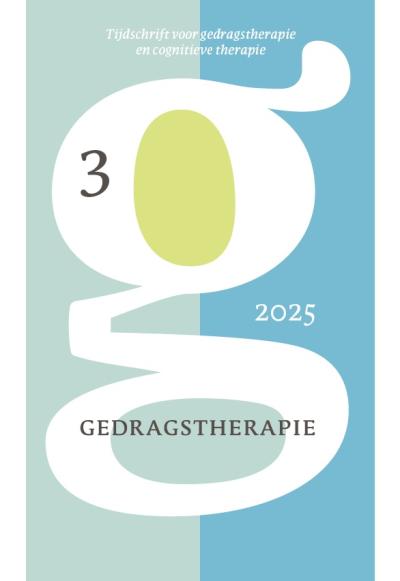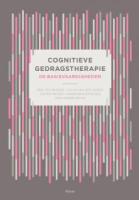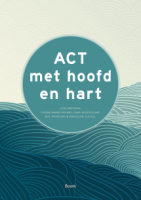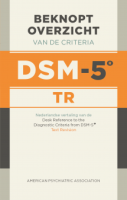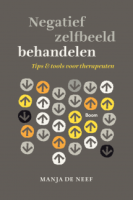Inhoud
De rol van repetitieve gedachten bij chronische pijn
Samenvatting
Het doel van dit literatuuroverzicht is om na te gaan of repetitieve negatieve gedachten een rol spelen bij chronische pijn. Allereerst wordt ingegaan op het bewijs voor een relatie tussen repetitieve negatieve gedachten en pijn. Vervolgens wordt ingegaan op de mogelijke mechanismen waarop repetitieve negatieve gedachten chronische pijn kan beïnvloeden. Onderzoeken naar de relatie tussen repetitieve negatieve gedachten en pijn laten tegenstrijdige resultaten zien en is vooralsnog ontoereikend. Een theoretisch model wordt voorgesteld waarin pijn motiveert om een oplossing te zoeken voor het pijnprobleem. Repetitief negatief denken houdt een cognitief pijnnetwerk in het geheugen actief waardoor angst voor pijn, selectieve aandacht en interpretatie, vermijding en hulp zoekend gedrag in een negatieve spiraal in stand worden gehouden of zelfs toenemen. Evidentie voor dit model is vooralsnog beperkt. Suggesties worden gedaan voor toekomstig onderzoek.
Literatuur
- Achterberg, W.P., Gambassi, G., Finne-Soveri, H., Liperoti, R., Noro, A., Frijters, D.H., Cherubini, A., Dell'aquila, G., & Ribbe, M.W. (2010). Pain in European long-term care facilities: cross-national study in Finland, Italy and The Netherlands. Pain, 148, 70-74.
- Aldrich, S., Eccleston, & Crombez, G. (2000). Worrying about chronic pain: vigilance to threat and misdirected problem solving. Behaviour Research and Therapy, 38, 457-470.
- Beesdo, K., Hoyer, J., Jacobi, F., Low, N.C.P., Höfler, M., & Wittchen, H. (2009). Association between generalized anxiety levels and pain in a community sample: Evidence for diagnostic specificity. Journal of Anxiety Disorders, 23, 684-693.
- Brown, T.A., Campbell, L.A., Lehman, C.L., Grisham, J.R, & Mancill, R.B. (2001). Current and lifetime comorbidity of the DSM-IV anxiety and mood disorders in a large clinical sample. Journal of Abnormal Psychology, 110, 585-599.
- De Vlieger, P., Crombez, G., & Eccleston, C. (2006). Worrying about chronic pain. An examination of worry and problem solving in adults who identify as chronic pain sufferers. Pain, 120, 138-144.
- De Vlieger, P., Van den Bussche, E., Eccleston, C., & Cormbez, G. (2006). Finding a solution to the problem of pain: Conceptual formulation and the development of the Pain Solutions Questionnaire (PaSol). Pain, 123, 285-293.
- Demyttenaere, K., Bruffaerts, R., Lee, S., Posada-Villa, J., Kovess, V., Angermeyer, M.C., Levinson, D., de Girolamo, G., Nakane, H., Mneimneh, Z., Lara, C., de Graaf, R., Scott,
- K.M., Gureje, O., Stein, D.J., Haro, J.M., Bromet, E.J., Kessler, R.C., Alonso, J., & Von Korff, M. (2007). Mental disorders among persons with chronic back or neck pain: results from the world mental health surveys. Pain, 129, 332-342.
- D'Hudson, G., & Saling, L.L. (2010). Worry and rumination in older adults: differtiating the processes. Aging and Mental Health, 14, 524-534.
- Eccleston, C., & Crombez, G. (1999). Pain demands attention: a cognitive–affective model of the interruptive function of pain. Psychological Bulletin,125, 356-66.
- Eccleston, C., & Crombez, G. (2007). Worry and chronic pain: A misdirected problem solving model. Pain, 132, 233-236.
- Eccleston, C., Crombez, G., Aldrich, S., & Stannard, C. (2001). Worry and chronic pain patients: A description and analysis of individual differences. European Journal of Pain, 5, 309-318.
- Eccleston, C., Williams, A.C.D.C., & Morley, S. (2009). Psychological therapies for the management of chronic pain (excluding headache) in adults (Review). Cochrane Database of Systematic Review, 2. Art. No.: CD007407.
- Ehring, T., & Watkins, E.R. (2008). Repetitive Negative Thinking as a transdiagnostic process. International Journal of Cognitive Therapy, 1, 192-205.
- Engel G.L. (1980). The clinical application of the biopsychosocial model. American Journal of Psychiatry, 137, 535-44.
- Evers, W.M, Kraaimaat, F.W., Geenen, R., & Bijlsma, J.W.J. (1998). Psychosocial predictors of functional change in recently diagnosed rheumatoid arthritis patients. Behaviour Research and Therapy, 36, 179-193.
- Forsythe, M.E., Dunbar, M.J., Hennigar, A.W., Sullivan, M.J.L., & Gross, M. (2008). Prospec tive relation between catastrophizing and residual pain following knee arthroplasty: Two-year follow-up. Pain Research and Management, 13, 335-341.
- Goubert, L., Crombez, G., & Danneels, L. (2005). The reluctance to generalize corrective experiences in chronic low back pain patients: a questionnaire study of dysfunctional cognitions. Behaviour Research and Therapy, 43, 1055-1067.
- Hayes, S.C., Strosahl, K., & Wilson, K.G. (1999). Acceptance and commitment therapy. New York: Guilford Press.
- Higgins, E.T. (2006). Value from hedonic experience and engagement. Psychological Review,113, 439–460.
- Jensen, M.C., Brant-Zawadzki, M.N., Obuchowski, N., Modic, M.T., Malkasian, D., & Ross, J.S. (1994). Magnetic resonance imaging of the lumbar spine in people without back pain. The New England Journal of Medicine, 331, 69-73.
- Kabat-Zinn, J. (1990). Full catastrophe living: using the wisdom of your body and mind to face stress, pain and illness. New York: Delacorte.
- Karsdorp, P.A., & Vlaeyen, J.W. (2011). Goals matter, Both achievement and pain-avoidance goals are associated with pain severity and disability in patients with low back and upper extremity pain. Pain, 152, 1382-1390.
- Karsdorp, P.A., & Vlaeyen, J.W. (2009). Active avoidance but not activity pacing is associated with disability in fibromyalgia. Pain, 147, 29-35.
- Kraaimaat, F.W., Bakker, A.H., & Evers, A.W.M. (1997). Pijncoping strategieen bij chronische pijn patienten:De ontwikkeling van de Pijn Coping Inventarisatielijst (PCI) [Pain coping strategies in chronic pain patients: The development of the Pain Coping Inventory (PCI)]. Gedragstherapie, 22, 267-277.
- Kraaimaat, F.W., & Evers, A.W.M. (2003). Pain-coping strategies in chronic pain patients: psychometric charecteristics of the pain-coping inventory (PCI). International Journal of Behavioural Medicine. 10, 343-363.
- Lackner, J.M., & Quigley, B.M. (2005). Pain catastrophizing mediates the relationship between worry and pain suffering in patients with irritable bowel syndrome. B ehavior Research and Therapy, 43, 943-57.
- Leeuw, M., Goossens, M.E., van Breukelen, G.J., de Jong, J.R., Heuts, P.H., Smeets, R.J., Köke, A.J., Vlaeyen, J.W. (2008). Exposure in vivo versus operant graded activiy in chronic low back pain patients: results of a randomized controlled trial. Pain, 138, 192-207.
- Lissek, S., Rabin, S., Heller, R.E., Lukenbaugh, D., Geraci, M., Pine, D.S., & Grillon, C. (2010). Overgeneralization of conditioned fear as a pathogenic marker of panic disorder. American Journal of Psychiatry, 167, doi:10.1176/appi.ajp.2009.09030410.
- McWilliams, L.A., Holmberg D. (2010). Adult attachment and pain catastrophizing for self and significant other. Pain, 149, 278-283.
- Means-Christensen, A.J., Roy-Byrne, P.P., Sherbourne, C.D., Craske, M.G., & Stein M.B. (2008). Relationships among pain, anxiety, and depression in primary care. Depression and Anxiety, 25, 593-600.
- Meyer, T.J., Miller, M.L., Metzger, R.L., & Borkovec, T.D. (1990). Development and validation of the Penn State Worry Questionnaire. Behaviour Research and Therapy 28, 487-495.
- Miró, J., Nieto, R., & Huguet, A. (2008). The Catalan version of the pain catastrophizing scale: A useful instrument to assess catastrophic thinking in whiplash patients. The Journal of Pain, 9, 397-406.
- Nijs, J., Van de Putte, K., Louckx, F., Truijen, S. & De Meirleir, K. (2008). Exercise performance and chronic pain in chronic fatigue syndrome:the role of paincatstrophizing. Pain Medicine, 9, 1164-1172.
- Oliveira, P., & Costa, M.E. (2009). Interrelationships of adult attachment orientations, health status and worrying among fibromyalgia patients. Journal of Health Psychology, 14, 1184-1195.
- Picavet, H.S., & Hoeymans, N. (2004). Health-related quality of life in multiple musculo skeletal diseases: SF-36 and EQ-5D in the DMC3 study. Annals of Rheumatic Diseases, 63, 723-729.
- Pincus, T., & Morley, S. (2011). Cognitive-processing bias in chronic pain: A review and integration. Psychological Bulletin, 127, 599-617.
- Romera, I., Fernández-Pérez, Montejo, S., Caballero, A.L., Caballero, L., Arbesú, J.A., Del gado-Cohen, H., Desaiah, D., Polavieja, P., & Gilaberte, I. (2010). Generalized anxiety disorder, with or without co-morbid major depressive disorder, in primary care: Prevalence of painful somatic symptoms, functioning and health status. Journal of Affective Disorders, 127, 160-168.
- Russell, J.M., Weisberg, R, Fava, M., Hartford, J.T., Erickson, J.S., & D'Souza, D.N. (2008). Efficacy of duloxetine in the treatment of generalized anxiety disorder in patients with clinically significant pain symptoms. Depression and Anxiety, 25, E1–E11.
- Samwel, H.J.A., Evers, A.W.M., Crul, B.J.P., & Kraaimaat, F.W. (2006). The role of helplessness, fear of pain, and passive pain-coping in chronic pain patients. Clinical Journal of Pain, 22, 245-251.
- Stimmel, T., Crayton, C., Rice, T., & Raffeld, P.M. (2006). Pain perception as a function of self-focused rumination. Perceptual and Motor Skills, 103, 21-28.
- Sullivan, M.L.J., Bishop, S.R., & Pivik, J. (1995). The Pain Catastrophizing Scale: Development and Validation. Psychological Assessment, 7, 524-532.
- Sullivan, M.J., Stanish, W., Waite. H., Sullivan. M,E., & Tripp, D.A. (1998). Catastrophizing, pain, and disability in patients with soft tissue injuries. Pain 77, 253-260.
- Sullivan, M.J., Thorn, B., Haythornthwaite, J.A., Keefe, F., Martin, M., Bradley, L.A., & Lefebvre, J.C. (2001). Theoretical perspectives on the relation between catastrophizing and pain. The Clinical Journal of Pain, 17, 52-64.
- Tallis, F., Eysenck, M., & Mathews, A. (1992). A questionnaire for the measurement of nonpathological worry. Personality and Individual Differences, 13, 161-168.
- Teh, C.F., Morone, N.E., Karp, J.F., Belnap, B.H., Zhu, F., Weiner, D.K., & Rollman, B.L. (2009). Pain interference impacts response to treatment for anxiety disorders. Depression and Anxiety, 26, 222-228.
- Turner, J.A., Holzman, S., & Mancl, L. (2007). Mediators, moderators, and predictors of therapeutic change in cognitive-behavioral therapy for chronic pain. Pain, 127, 276-286.
- Tremblay, I., & Sullivan, M.J.L. (2010. Attachment and pain outcomes in adolescents: the mediating role of pain catastrophizing and anxiety. The Journal of Pain, 11, 160-171.
- Ursin, H. (2005). Press stop to start: the role of inhibition for choice and health. Psychoneuroendocrinilogy, 30, 1059-1065.
- Van Damme, S., Crombez, G., Vlaeyen, J.W.S., Goubert, L., Van den Broeck, A., & Van Houdenhove, B. (2000). De Pain Catastrophizing Scale: Psychometrische karakteristieken en normering. Gedragstherapie, 33, 209-220.
- Van Damme, S., Legrain, V., Vogt, J., & Crombez, G. (2010). Keeping pain in mind: a motivational account of attention to pain. Neurosciences and Biobehavioral Reviews, 34, 204-213.
- Van Eerd, D., Côté, P., Kristman, V., Rezai, M., Hogg-Johnson, S., Vidmar, M, & Beaton, D. (2011). The course of work absenteism involving neck pain: a cohort study of ontario lost-time claimants. Spine, 36, 977-982.
- Veehof, M.M., Oskam, M., Schreurs, K.M.G., & Bohlmeijer, E.T. (2011). Acceptance-based interventions for the treatment of chronic pain: A systematic review and meta-analysis. Pain, 152, 533-542.
- Vlaeyen, J.W., & Linton, S.J. (2000). Fear-avoidance and its consequences in chronic musculoskeletal pain: A state of the art. Pain, 85, 317-332.
- Wells, A. (1995). Meta–cognition and worry: A cognitive model of generalized anxiety disorder. Behavioural and Cognitive Psychotherapy, 23, 301-320.
- Wijnhoven, H.A.H., Vet, H.C.W. de, & Picavet, S.J. (2006). Prevalence of Musculoskeletal disorders is systematically higher in women than in men. Clinical Journal of Pain, 22, 717-724.
 © 2009-2025 Uitgeverij Boom Amsterdam
© 2009-2025 Uitgeverij Boom Amsterdam
De artikelen uit de (online)tijdschriften van Uitgeverij Boom zijn auteursrechtelijk beschermd. U kunt er natuurlijk uit citeren (voorzien van een bronvermelding) maar voor reproductie in welke vorm dan ook moet toestemming aan de uitgever worden gevraagd:
Behoudens de in of krachtens de Auteurswet van 1912 gestelde uitzonderingen mag niets uit deze uitgave worden verveelvoudigd, opgeslagen in een geautomatiseerd gegevensbestand, of openbaar gemaakt, in enige vorm of op enige wijze, hetzij elektronisch, mechanisch door fotokopieën, opnamen of enig andere manier, zonder voorafgaande schriftelijke toestemming van de uitgever.
Voor zover het maken van kopieën uit deze uitgave is toegestaan op grond van artikelen 16h t/m 16m Auteurswet 1912 jo. Besluit van 27 november 2002, Stb 575, dient men de daarvoor wettelijk verschuldigde vergoeding te voldoen aan de Stichting Reprorecht te Hoofddorp (postbus 3060, 2130 KB, www.reprorecht.nl) of contact op te nemen met de uitgever voor het treffen van een rechtstreekse regeling in de zin van art. 16l, vijfde lid, Auteurswet 1912.
Voor het overnemen van gedeelte(n) uit deze uitgave in bloemlezingen, readers en andere compilatiewerken (artikel 16, Auteurswet 1912) kan men zich wenden tot de Stichting PRO (Stichting Publicatie- en Reproductierechten, postbus 3060, 2130 KB Hoofddorp, www.cedar.nl/pro).
No part of this book may be reproduced in any way whatsoever without the written permission of the publisher.
Inloggen VGCt en VVGT
Leden van de VGCt en de VVGT loggen in via de site van hun vereniging. Als u op die site bent ingelogd als lid, vindt u daar een button naar het Tijdschrift voor Gedragstherapie.
English
Behavioral Therapy: Journal for Behavioral Therapy and Cognitive Therapy ISSN 0167-7454
Information in English can be found here.



